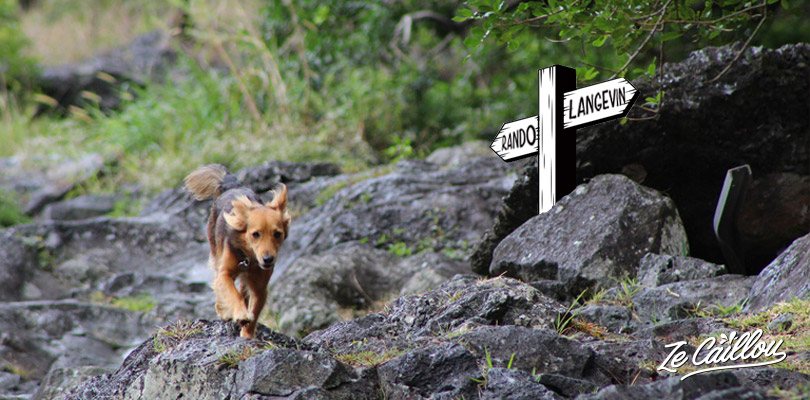Travel with a dog
You really want to bring your pet with you? We totally understand. We bring our dog, Huacachina everywhere, every time we can. But, for sure, it requires a little organization.
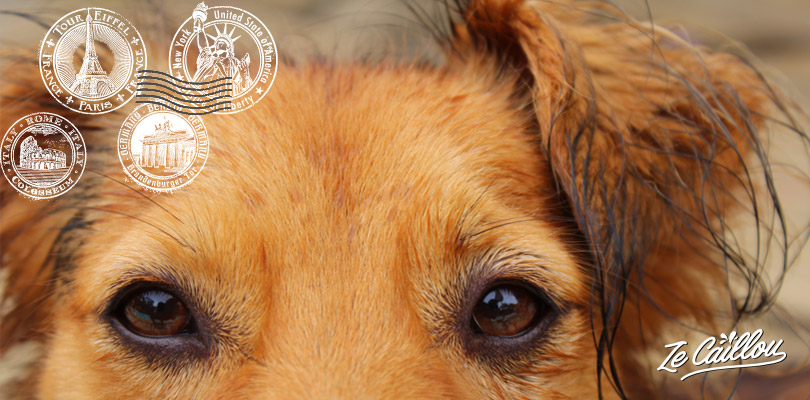
Travelling in a foreign country with a dog
Foreign countries’ regulations?
Everything depends on your destination. Regulations are different from a country to another, and not just a little. You can have “no” quarantine at all, or several weeks. And we didn’t say a word about paperwork and medical tests. Also, it’s good to keep in mind that usually, islands’ regulations (like Australia, UK…) are stricter (disease propagation risks…). Do some research with your destination country’s embassy.
Big trends about countries’ regulations for animals*:
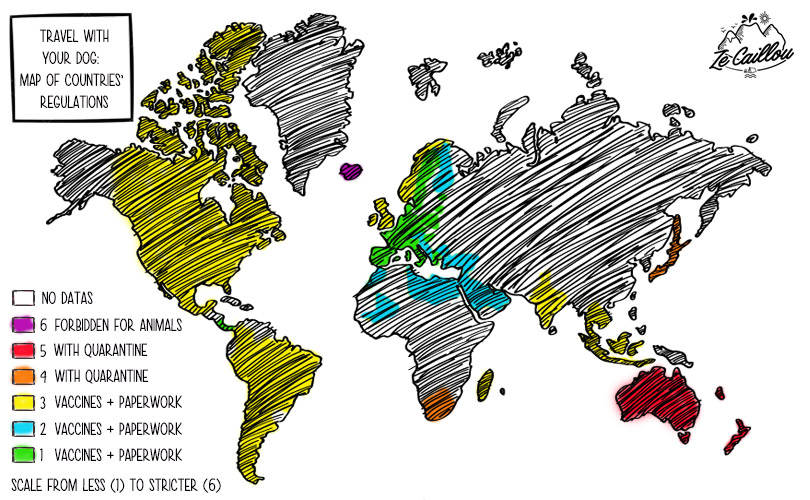
However, regulations change very quickly. The best option is to find out about the actual regulation with your destination country’s embassy. The pettravel website is a good source for any information linked to travel and animals. On their passport section, you can directly make a research by country.
*Based on Routard’s « 2017 Dog guide »‘s datas.
Required elements to travel in Europe
- Dog’s vaccines (including rabies) and health record booklet must be updated
- Animal must be identified by electronic microchip
- You must have your dog’s European passport
- When you come from tropical places (like us), it’s recommended to make dirofilariose and ehrlichiose tests (tropical diseases).
- Your vet must make a good health certificate 5 days maximum before your travel.
- Be careful: for UK, Ireland, Sweden, Malta… regulations are stricter and can change. For example, before entering UK, you must see a vet for a certificate:
- that says your dog took vermifuge
- which attests your dog has a treatment against fleas and ticks
- of good health
We’ll update soon this part of the article when crossing Europe borders! Traveling with a dog in Europe will be no longer a secret to you.
Take a plane with your dog or cat
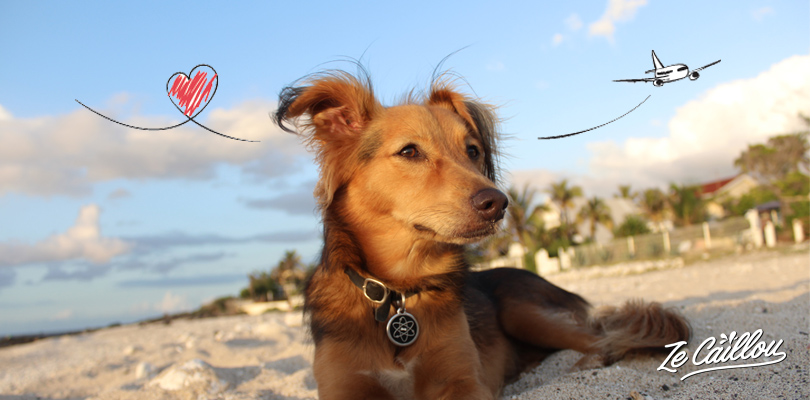
Before taking a plane with an animal, there are 2 or 3 things to know. First, contact different airlines to compare their regulation. Animal breed, pet travel carrier, medicines, ticket’s price.
Except dogs and cats, animals will have to travel by cargo. Be careful about dogs’ breeds, some are forbidden (dogs that can be dangerous and snub noses dogs, because of breathing difficulties mettre les races concernées ?).
Travel conditions also change between airlines and destinations. Information you’ll find below have been compared between Air France, Air Austral and Corsair (La Reunion > Paris).
Key numbers when travelling by plane with a dog
- Cabin or baggage hold?
- Cabin: usually, your dog and his bag must weight 5 kg maximum to be accepted in the airplane cabin. Up to 8kg for Air France.
- Baggage hold: depending on the airline, animals are accepted up to 50/75kg (carrier including).
- Cargo: beyond 50/75kg.
- Age? To travel, your puppy must be older than 2 months.
- Prices? Traveling in cabin is in general a little cheaper. Prices are different depending on the airline. The average is between 20 and 100€ in European countries (and French overseas departments and territories). And up to 200€ for foreign countries.
- Paperwork? Check with your airline, but in general you’ll have to show: vaccines record booklet, good health certificate, identification proof…
- Pet travel carrier? To take the plane you’ll need a pet travel carrier fully compliant with IATA standards and adapted to his size. Be careful, do not take it too small. Some friends have already been refused in the plane (their dog to be precise) because of a too tiny cage. The animal must be able to be on his legs inside the cage without discomfort. Advice: do not buy it at the last moment, because:
- It’s a budget (between 50 and 200€ depending on the brand and the size of your dog).
- It’s highly recommended to get your dog used to enter his cage. It will avoid big stress on the D Day.
- Medicine? The best is to talk about that with your vet (antistress, sleeping pills…).
Other advices for your pet travel
- Make him run a little before putting him in his travel carrier for hours.
- Don’t give him food just before departure (at least 4 hours before).
- Make him a comfortable cage (with a carpet or mattress in it).
- Put one of your used sportswear in it!
Your dog’s favourite equipment?
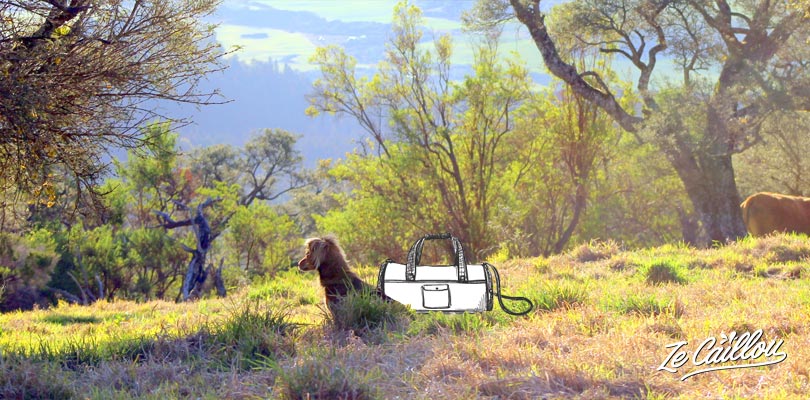
Beside your needs linked to the travel (plane, cage…), your pet also needs some stuff!
Here, things you’ll really need, and even a little more:
- 1 leash. Even very well behaved, a lot of places do not accept animals without leash.
- 1 flexible dog’s bowl. Way more easier to carry with you.
- 1 luminous collar. It sounds like a gadget, but it’s really useful when you are outside by night. We use it very often when we go camping or else. You’re not obliged to look after your dog all night long and he can still be free.
- 1 spiral stake. When you’re outside, you can screw it into the floor and attach your leash on it. Again, very useful when camping.
- Winter clothing…maybe the worst in terms of ridicule… But if you travel in a very cold country you must think that your dog’s hairs won’t be sufficient. Furthermore when like us, you come from an Island. Let’s go for a funny shopping to find his perfect jacket and socket!
Go out with your dog: focus on La Reunion
Once in Reunion, there are no particular restrictions.
In details:
Hiking.
Most of the time, there is no problem. Just check in advance the steps of your walk (ladder, tunnel, basin). Most of all if you’re alone with your animal, because some paths could be a little tricky. And will need a 2nd person to take the dog from a side to another. Personally, Huaca come with us everywhere, just 1 or 2 walks have been too difficult for her.
Beaches.
Dogs are forbidden after 8am and until 6pm. So you can totally go for a walk in the early morning or for the sunset during summer. Plus, if your dog likes water like ours, it’s will be pure joy!
Restaurant/beach bar.
It will depend on the place where you want to go. We always call before to know if animals are allowed. In general, when there are open sites (outside terrace, beach restaurant) and if you have a leash, it’s OK. Of course, for closed restaurants it’s more difficult…
Hostels and holiday cottages.
Some hostels and cottages allow animals. Of course, you should have a well behaved dog and come with a leash in case of problem. Here, some dog-friendly places : Gite Îlot Paradisiaque in l’Entre-Deux, La Cabane du Raideur, Le Bois Rouge, le A Li Mèm Mèm, Le Tsilaosa in Cilaos, Au Pieds des Cascades et l’Orchidée Rose in Salazie, la Cabane du Zèbre in Saint-Gilles….
